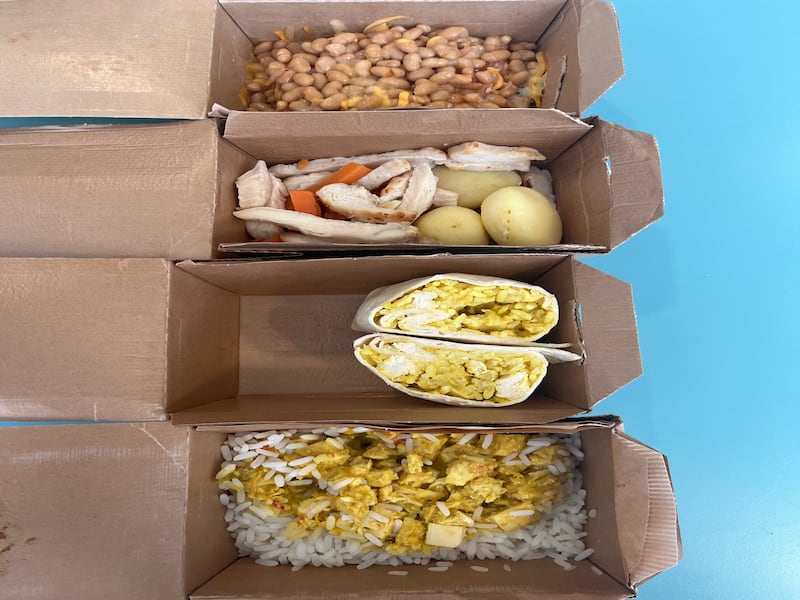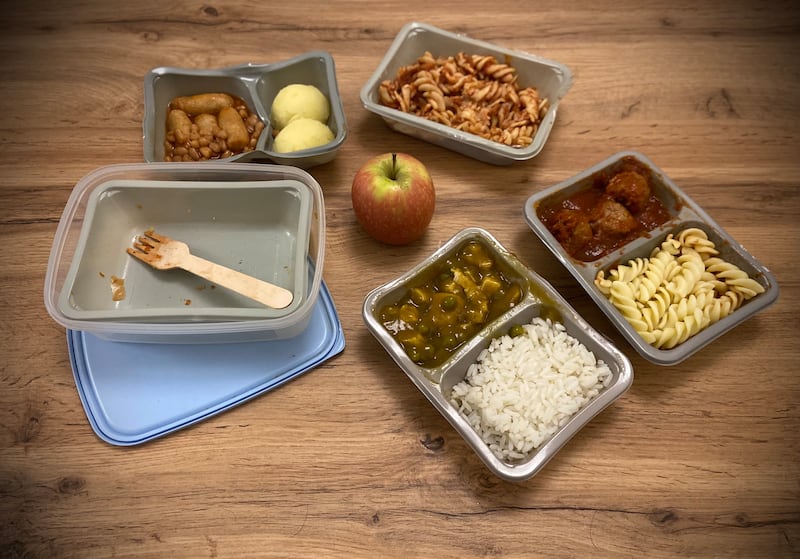The Government’s school meals programme, which aims to provide a free hot lunch to all primary schoolchildren by 2030, has been rolled out to 1,400 schools in a pilot project, 900 of them joining the scheme last month. It looks likely that the original target date for delivery will be met much earlier than planned, perhaps as soon as next year. The programme is administered by the Department of Social Protection, which budgets €3.20 for each meal, and the procurement process is managed by the participating schools.
The scheme has been widely welcomed, but questions have been raised about the sourcing of ingredients for some of the meals on offer and the sustainability of some of the packaging used. We took a look at how the new scheme is currently working in two primary schools, in Co Kildare and Co Limerick.
The teacher’s view
Evanna Linehan teaches junior infants at Coill Dubh National School in Naas, Co Kildare, which has 182 children on the roll. The school joined the pilot scheme last month.
“The meals arrive every day and we have two big ovens, which look a bit like what you might see on an aeroplane, and the meals go in there. They have two test meals with probes in them, to make sure they get to the correct temperature,” Linehan says.
READ MORE
The meals are heated up by two people who were trained in the process by the supplier and are paid by them. The hot meals are then delivered in an insulated box outside each classroom about five to 10 minutes before lunchtime. Parents or guardians select meals for their children from The Lunch Bag’s app, and there is a wide variety of choice. Allergens are noted in the ingredients lists on the app, and there are vegetarian, gluten-free and halal meat options.
Linehan says her class are enjoying the meals, but they are less popular with some of the older children. “I have junior infants and it’s going down very well with them, really. Actually, I am surprised how well they’re doing with it. Up the school, I think it can be a little harder. At the end of the meal, they put their boxes back into the main box, and some of them are just putting it back in uneaten. The teachers maybe aren’t always aware, so that’s a problem. Parents don’t know what the kids have eaten that day. But in my class I only have 15 [children] so I’m able to watch carefully and make sure everybody is eating and if they haven’t to offer something else to them.”
Linehan doesn’t mind the hot meal supervision: “I put it down as social and personal health education. The meals come with [disposable] wooden forks, so I just bought some cheap forks, just to make it a more pleasurable eating experience, and we set the table with your napkin and your fork.”
The most popular meals at this school are a pepperoni pizza sub, chicken goujons and wedges, and chicken curry and rice. “The roast chicken dinner looks delicious, but not many of them seem to order it. I actually tasted it and it’s quite nice. It’s similar up the school, the same things seem to be popular,” Linehan says.
Overall, Linehan sees the scheme as being a positive move. “I would say that it is definitely very sociable. And I have a couple of children in my class who would be fussy, and it’s certainly encouraging them to try new foods. They are looking around the room at their peers, and are willing to try a food and give things a go.”
The food writer’s view
To assess the meals on offer to one school participating in the pilot scheme, we obtained four options that had been delivered to the school. They had been previously reheated and stored in a fridge before being examined and tasted. It should be noted that the supplier recommends that they be destroyed two hours after heating, if not eaten.
First impressions are that the portions are big, certainly enough for older primary schoolchildren. The four meals we receive are chicken curry and rice; roast chicken potatoes and carrots; chicken curry wrap, and a baked potato, baked beans and cheese.
The pupil’s name and class, and the nutritional values of the meal are printed on the label affixed to the cardboard box, which is about the same size as a regular microwave meal container.

Chicken curry and rice: This is one of the most popular choices at the school this meal was delivered to. It is a reasonably large portion of white long grain rice, nicely cooked, topped with diced chicken breast in a very mild, fruity, curry sauce. There are a few very small strips of red pepper, but there may have been more vegetables hidden in the sauce. Inspection of the ingredients reveals that the meal contains red pepper, rice, curry sauce and diced chicken. There is no indication of what is in the curry sauce. The only allergen listed is milk.
Roast chicken, carrots and potatoes: This is the tastiest of the four meals, with the chicken breast having a proper roasted chicken flavour and texture. There is no gravy with it though, and it is a bit dry to eat. The boiled or steamed peeled baby potatoes and carrot batons are nicely cooked and fresh tasting.
Chicken curry wrap: The white flour wrap is filled with what seems to be the same mixture of chicken curry and rice that is offered separately. It is all bit carb-heavy, and very filling. But children might enjoy the hands-on nature of eating it, rather than the box of rice and curry. Gluten and milk are noted as the allergens.
Baked potato, baked beans in tomato sauce and grated cheese: What parent hasn’t served this inexpensive and nutritious meal to a child? Hopefully there is not too much sugar in the baked beans. Otherwise, it appears to be a fairly healthy option, well executed and it stands up well to the transportation and reheating.
The meals we tried were supplied by The Lunch Bag, a firm based in Nenagh, Co Tipperary, set up in 2019 by Ger Killian, managing director, and Ray Nangle, chief executive. “We started off with just my son’s school in Athlone, and delivered 180 handmade sandwiches,” Killian says. They still offer a cold lunch delivery to schools not included in the Government’s pilot scheme, but have expanded to focus on delivering ready-to-heat meals to schools that are.
The company has a production workforce of more than 200, including an in-house dietitian, and also employs 440 people on a part-time basis in schools to heat the meals and deliver them to classrooms. The company’s website lists the Irish suppliers of its ingredients, including Ballymaloe Foods, whose sauces contain “hidden” vegetables such as celery, onions and carrot, along with tomatoes. “We could save [money] by switching to a supplier that uses more sugar in their sauces,” says Killian.
She says that the company sources its ingredients from Irish suppliers and prioritises quality. “€3.20 a meal is a tight margin, it is hard work,” she says. “But we are going into it to make a difference. Our own children eat the meals, and staff eat them on their breaks.” – Marie Claire Digby

The parent’s view
“It’s just like my granny’s dinner”, this was just one of the many glowing reviews Siobhán Kennedy, principal of Ahane National School in Ahane, Co Limerick, has overheard from her pupils since the Hot School Meals programme commenced in the school in April.
A small rural school with 160 pupils, Ahane NS was one of 900 schools chosen to participate in the pilot of the programme and to date, she said it has been a great success.
“We are delighted with our food. The children love it ... the quality is excellent, the children love the variety. It is all very positive, from the children’s perspective and from the staff’s perspective as well,” Kennedy said.
She explained that the food arrives at the school heated, in boxes that are left outside the classrooms in time for lunch. Each child receives individual portions of their chosen hot lunch, in 100 per cent recyclable packaging. When the child is finished eating, they bring the packaging home, so parents can see what their child has eaten that day. This provides an important link between home and school, Kennedy said. The temperature of the food has also been perfect for the children, she added.
When choosing the supplier, Kennedy had several strict criteria, top of which was the quality of the food. Additional criteria included waste management, flexibility and the ability of the supplier to fit in with the school’s busy schedule. She said they are delighted with the supplier they chose; a small local food business called Gourmet Kids, based in the Raheen Industrial estate in Limerick.
Gourmet Kids is owned by Mary and Pat Power both of whom are proud of the food they produce. “We focus on the food and make sure the quality of the food is good. That is what we are about,” Mary Power said. Gourmet Kids makes approximately 5,000 meals a day and delivers to 40 schools in Limerick, Clare and Tipperary.
Mary explains that they purchase their ingredients from local suppliers and all produce is made within the EU. All the food is made from scratch and no jars are involved.
“For us, it’s about really good quality ingredients. We spend the money on good quality ingredients, things like naturally sweet tomatoes. We don’t add anything to our food, we use natural, good ingredients and that is what gives us the flavour,” she said.
We want the kids to never tire of our food and if there is waste, it is because the food isn’t good enough
— Mary Power - Gourmet Kids
All the food served meets the Nutritional Standards for Hot School Meals published under the auspices of Healthy Ireland, the national framework that aims to improve the health and wellbeing of the population of Ireland. They have been developed for the Department of Social Protection by the Department of Health, safefood and the HSE.
These guidelines also state that processed food such as burgers, chicken goujons or sausages can only be served once a week. In Ahane NS, this happens on Fridays.
All of the packaging used by Gourmet Kids is 100 per cent recyclable and the packaging itself is made from 70 per cent recycled product. All the recyclable food trays provided are part of a circular economy that can be recycled back into food trays again. Schools can choose to send the packaging back home with the children or return it to Gourmet Kids, who ensure it is recycled.
“We want the kids to never tire of our food and if there is waste, it is because the food isn’t good enough. We want to make sure that the food is eaten, so your tray should be always coming home empty, unless the child just doesn’t like something. But then you can pick something different,” Mary Power said.
From a parent’s perspective, the Hot School Meals Programme has been a game-changer in our house.
My daughter Clodagh attends Ahane NS and loves the hot lunches, which is evident by the empty lunch box that comes home every day. The choice available is very wide and all special dietary requirements are catered for.
[ Hot school meals programme expanded with 900 more locations joining schemeOpens in new window ]
Parents have access to an account on the Gourmet Kids website where together with their child they can choose from more than 40 meals including chicken curry and rice (a favourite in our house), pasta Bolognese; meatballs and pasta; roast beef/chicken with mash, gravy and vegetables; tacos; burritos; vegetable curry; cauliflower wings; lasagne; Singapore noodles, to name just a few. Orders are made a week in advance, so if your child doesn’t like anything they can change their order for the following week. There are also options such as plain pasta, and parents can also choose no meal on the days when they know their child will not be in school.
Parents can also choose to opt-out all together and continue to make their child their usual lunch box from home.
Another positive aspect of the scheme is the peer factor, with children seeing what their friends are having for lunch and deciding to try that too, this helps to expand their young palates and encourages them to try new things.
The choice and quality of the food my daughter receives is undoubtedly better than the usual ham sandwich and fruit that I would prepare, and crucially the hot meal is eaten, which is not something I can always say about my offerings from home. It happened to be a Friday when I sampled it, so sausages and mash and pizza pasta were on the menu. The food was very tasty.
The kids are given a reusable plain plastic lunch box which they use for their small break and this in turn is also used to bring home their empty packaging. This has meant that our kitchen cupboard is no longer overflowing with unused lunch boxes.
While free hot school meals have been available in DEIS schools for some time now, as a working parent I warmly welcome the roll-out of the programme to all schools. It has not only reduced the grocery bill, but also the stress levels, by having one less thing to worry about when trying to get the kids out the door to school on time.
– June Shannon is a journalist and mother of Clodagh, who attends Ahane National School, Co Limerick



















